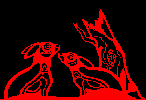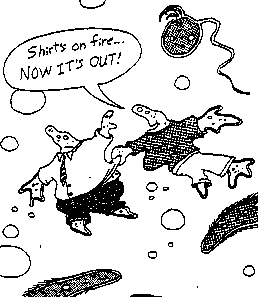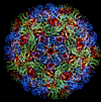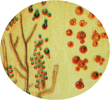| |
Viruses |
 |

The primary purpose of
a liberal education is
to make one’s mind a pleasant place in
which to spend one’s leisure
Sidney J. Harris |
 |
| |
Humour in its lowest form |
Who am I?
Together with Jean Lindenmann, we discovered and isolated
interferon, the first cytokine

| DEFINE THE FOLLOWING KEY
TERMS
|
| Viruses |
Host Range |
bacteriophage |
phage |
| virion |
capsid |
capsomere |
viral envelope |
| spikes |
peplomer |
hemagglutinin |
hemagglutination |
| polyhedral viruses |
icosahedron |
Complex virus |
helical virus |
| plaques |
plaque forming units |
cytopathic effect |
CPE |
| Lytic cycle |
burst time |
burst size |
lysogenic cycle |
| specialized transduction |
endocytosis |
Viral Fusion |
Siglum |
| Sigla |
Sense strand RNA |
Antisensestrand RNA |
Reverse Transcriptase |
| Prions |
Viroid |
Adenovirus |
Poxvirus |
| Herpesvirus |
Papovavirus |
Hepadnavirus |
Togavirus |
| Reovirus |
Retrovirus |
Picornavirus |
provirus |

- How do viruses differ from bacteria?
- Give four characteristics that define viruses.
- Describe the chemical and physical structure of bath an
enveloped and a non enveloped virus.
- What is the chemical composition of a capsid?
- Describe how bacteriophages are cultured.
- Describe how animal viruses are cultured.
- What is a plaque forming unit?
- LIST three techniques used to identify viruses.
- Describe the lytic cycle of T even bacteriophages.
- Describe the lysogenic cycle of T even bacteriophages.
- List 5 stages in order of the T even bacteriophage lytic
cycle.
- How does lysogeny differ from the lytic cycle?
- Compare and contrast the multiplication cycle of DNA and
RNA containing animal viruses.
- How does specialized transduction differ from the lytic
cycle?
- Compare viral penetration by endocytosis and by fusion.
- List 7 steps in order for the multiplication of a DNA
virus such as Papovavirus.
- Why is the - strand RNA made by picornaviruses and
reoviruses? by rhabdoviruses?
- How does the biosynthesis of a retrovirus differ from
that of other RNA viruses?
- Differentiate between slow viral infections and latent
viral infections
- Discuss how a protein (eg prion) can be infectious.
- Differentiate among virion, viroid and prion.
- Why do we classify viruses as obligatory intracellular
parasites?
- Describe the four morphological classes of viruses, then
diagram and give an example of each.
- Vibrio cholerae produces toxin and is capable of causing
cholera only when it is lysogenic. What does this mean?
- Describe how bacteriophages are detected
- Discuss the aruguments for and against the classification
of viruses as living organsims.
- Prophages and proviruses have been described as being
similar to bacterial plasmids. What similar properties do
they exhibit? How are they different?
- A newborn female developed extensive vesicular and
ulcerative lesions over her face and chest. What is the
most likely cause of her symptoms? How would you
determine the viral cause of this disease without doing a
viral culture?

![]()

![]()


